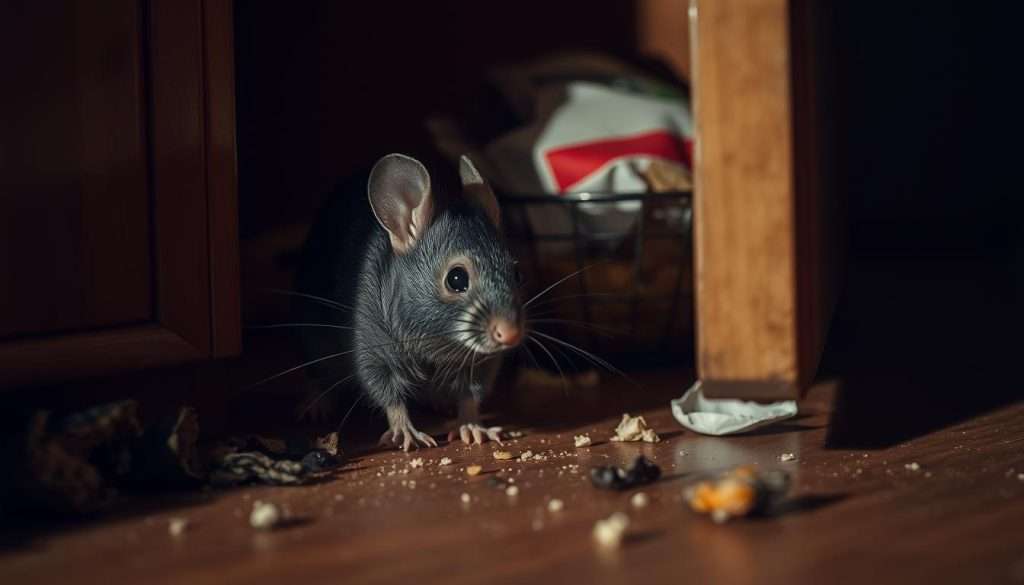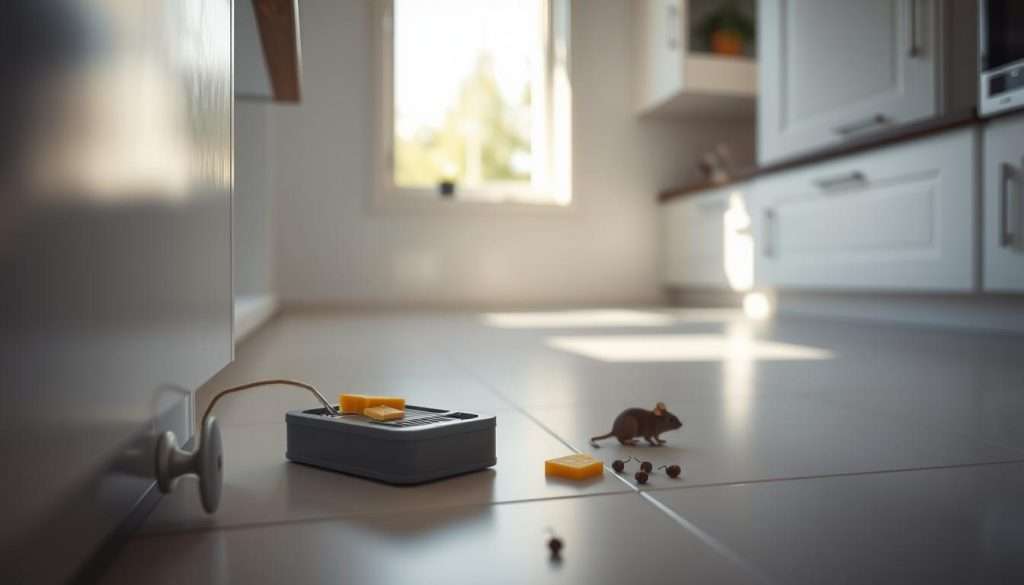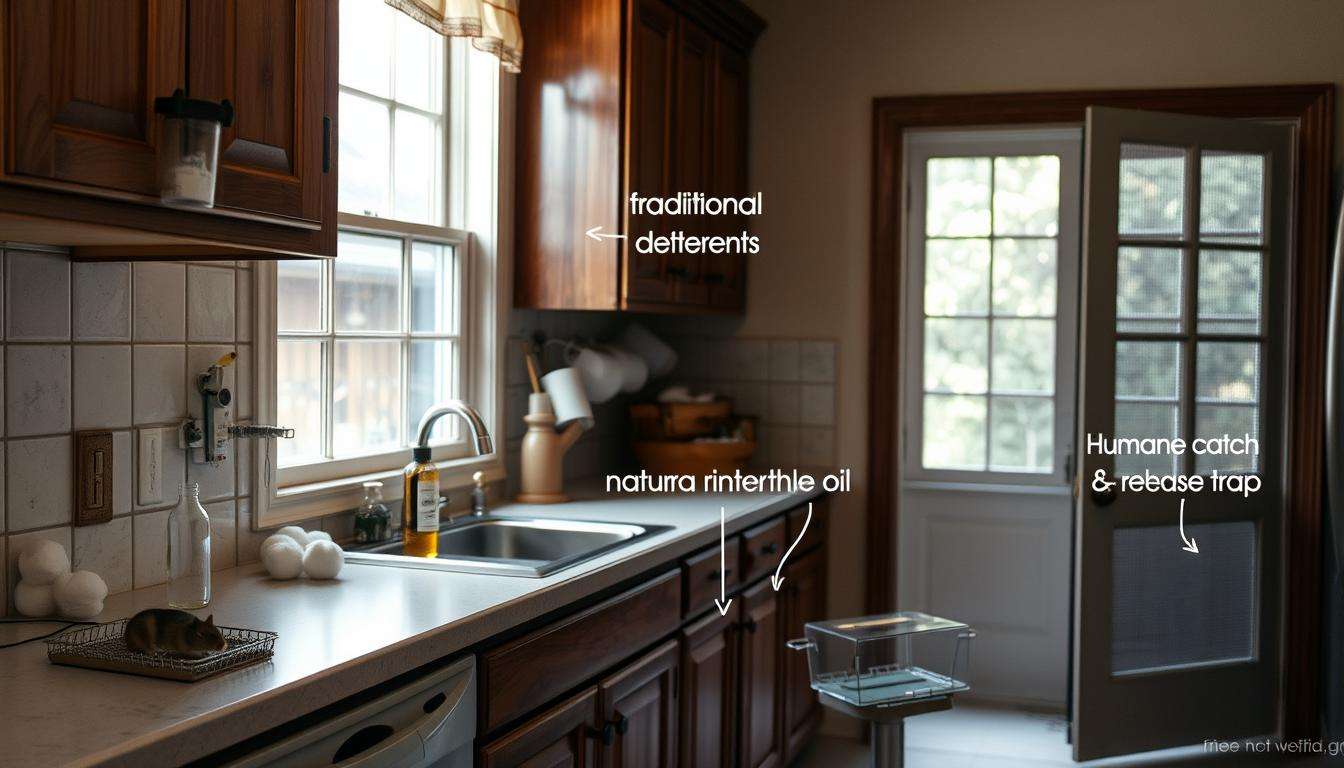Dealing with mice is more than a small problem. It can harm your health and damage your home. Mice carry diseases like Hantavirus and salmonellosis. These are very dangerous for kids.
They can have lots of babies fast. One female mouse can have up to eight litters a year. This means up to 100 new mice in just a few months.
Knowing how to quickly get rid of mice is key. This article will give you tips on mouse behavior, signs of infestation, and how to remove them. We’ll also cover how to prevent them from coming back. Let’s find fast and effective ways to keep your home safe and healthy.
Key Takeaways
- Mice can enter through cracks as small as 1/4 inch.
- Mouse extermination is necessary due to health risks associated with their presence.
- Effective traps are usually snap traps, often baited with peanut butter.
- A professional pest control treatment may cost between $150 and $250.
- Regular home inspections help in preventing future mouse infestations.
Understanding Mouse Behavior and Infestation Signs
Knowing how mice behave is key to controlling them. These creatures love warmth and shelter, especially when it’s cold. They’re drawn to easy food, making homes a perfect spot for them. Mice can fit through tiny openings, like a quarter of an inch.
You can find signs of mouse infestation like droppings and gnaw marks. These signs show they’re there and what they’re up to.
Why Mice Enter Homes
Mice come inside for warmth and food. They’re great climbers and find tiny gaps in homes. They’re most active at night, looking for food like crumbs and fruits.
If your kitchen or pantry isn’t sealed well, mice see it as a feast. For more on stopping them, check this resource.
Signs of a Mouse Infestation
Spotting signs of mouse infestation early can stop a big problem. Look for:
- Droppings: Look like dark rice grains and are in groups.
- Gnaw Marks: Chewed wood, plastic, and fabrics show they’re foraging.
- Nests: Made from paper and insulation, often hidden.
- Unusual Noises: Sounds of scratching and scampering at night.
- Odor: A strong ammonia smell means there are many mice.

By knowing mouse behavior and spotting these signs, you can keep mice away. This makes your home cleaner and safer.
| Sign of Infestation | Description |
|---|---|
| Droppings | Dark, grain-like pellets found in clusters, indicative of mouse activity. |
| Gnaw Marks | Visible chew marks on various materials indicating foraging behavior. |
| Nests | Made from shredded materials, often hidden in corners or behind appliances. |
| Unusual Noises | Scratching sounds coming from walls or ceilings during the night. |
| Odor | A strong, ammonia-like smell in the vicinity can signal many mice. |
How to Get Rid of Mice in Your House
To get rid of mice, you need a good plan. Understanding their habits helps. Then, you can use smart ways to keep them out of your home.
Steps for Effective Mouse Removal
Here’s how to remove mice well:
- Locate Entry Points: Mice can squeeze through tiny openings. Look for cracks and holes around windows, doors, and basements.
- Set Traps: Use mouse traps wisely. Choose humane traps or snap traps where you see mice. Use tasty bait like peanut butter or cheese.
- Clear Clutter: Get rid of clutter in garages and kitchens. This helps keep mice away and keeps your home clean.
Types of Mouse Traps
It’s important to pick the right mouse traps for humane removal. Here are some options:
- Humane Traps: These catch mice alive. Make sure to release them at least 10 miles away to keep them from coming back.
- Snap Traps: These kill mice fast. But, make sure they’re safe for pets and kids.
- Catch-and-Release Traps: These work like humane traps but let you release the mice safely.

Natural Solutions for Mouse Control
Natural solutions can help with mouse control. They offer protection and peace of mind. You can use essential oils and make DIY mouse traps from common items. This is creative and eco-friendly.
Essential Oils as Mouse Repellents
Essential oils can keep mice away because of their strong smells. Mice don’t like smells like peppermint, cayenne pepper, and cloves. Here are ways to use essential oils:
- Saturate cotton balls with peppermint oil and put them near where mice might get in.
- Try other smells like eucalyptus or citronella. Look for liquid deterrents.
- Some people use apple cider vinegar-soaked cotton balls or fabric softener sheets to keep mice away.
DIY Mouse Traps
DIY mouse traps are a good alternative to store-bought ones. Here are some ideas:
- Bucket Trap: Fill a bucket with water. Make a ramp and bait it with peanut butter. The mouse falls in.
- Box Trap: Make a humane trap from a cardboard box. Set it up to trap the mouse inside.
- Baited Traditional Traps: Use bait on standard traps. Make sure to reset and check them often.
Using natural solutions for mouse control can be helpful. Essential oils and DIY traps are effective. They might not solve big mouse problems, but they help with small ones.
Preventing Future Mouse Infestations
To keep your home mouse-free, prevention is key. Using mouse prevention tips can save you time, money, and health risks. It’s a smart move.
Sealing Entry Points
Mice can squeeze through tiny holes, like a pencil eraser. Sealing these spots is crucial to keep them out. Here’s how to do it:
- Use silicone caulk and steel wool to block gaps and holes around your home.
- Install rust-resistant wire screens over vents and chimney openings.
- Check and repair cracks in walls and foundations, as they can be common entry points.
- Place door sweeps on all exterior doors to eliminate gaps.
Maintaining a Clean Environment
A clean home reduces mouse infestations. Here are some tips:
- Store food in airtight containers made of glass or metal.
- Promptly clean up any spills and crumbs to avoid attracting mice.
- Avoid clutter, as it offers ideal nesting spots for rodents.
Regular Home Inspections
Routine maintenance is vital for mouse prevention. Regular home inspections help spot issues early:
- Inspect for signs of mouse activity, such as droppings or gnaw marks.
- Evaluate weatherstripping effectiveness and replace it as needed.
- Look for gaps around plumbing and electrical lines, sealing them promptly when found.
Conclusion
Dealing with mice at home needs a proactive approach. Knowing how mice behave and how they get in is key. Spotting early signs and acting fast can stop a small issue from getting worse.
Use traps, natural repellents, and check your home often. These steps help keep mice away. Remember, mice can fit through tiny openings, so check your home well.
Keeping your home clean and sealing holes helps a lot. Be extra careful in cold months, like in Maryland, when mice look for warmth.
Start these steps early to fight off mice better. You can do it yourself or get professional help. Always watch for signs and take steps to keep your home mouse-free.
